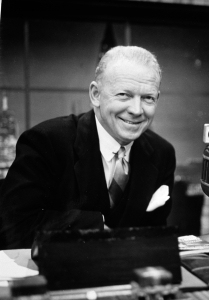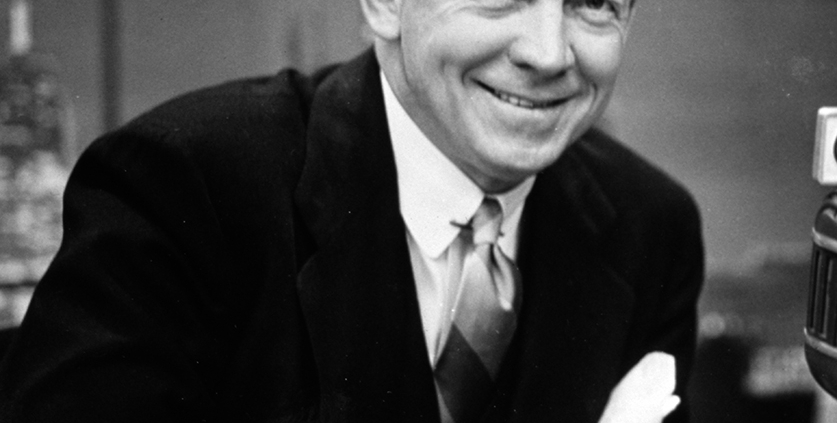August 26, 1939: Reds beat Dodgers in first televised game in ‘Comedy of Errors’
 Seated at a table in a lower box seat among 33,535 fans at Ebbets Field,1 Red Barber was ready to make history. Television was one of the exhibits at the 1939 World’s Fair in New York City, so NBC wanted the opportunity to broadcast a baseball game. A reader might wonder why the Brooklyn Dodgers? Why not one of the other New York teams – Giants or Yankees? NBC was aware that those two teams “didn’t like broadcasting,”2 and asked Barber to approach Dodgers President Larry MacPhail about being the first to broadcast a major-league game. Barber met with MacPhail in person and received an enthusiastic “yes.”3
Seated at a table in a lower box seat among 33,535 fans at Ebbets Field,1 Red Barber was ready to make history. Television was one of the exhibits at the 1939 World’s Fair in New York City, so NBC wanted the opportunity to broadcast a baseball game. A reader might wonder why the Brooklyn Dodgers? Why not one of the other New York teams – Giants or Yankees? NBC was aware that those two teams “didn’t like broadcasting,”2 and asked Barber to approach Dodgers President Larry MacPhail about being the first to broadcast a major-league game. Barber met with MacPhail in person and received an enthusiastic “yes.”3
Anyone within 50 miles could watch the game on television station W2XBS, broadcasting from the Empire State Building – if they were among the 400 or so who owned a set,4 or were lucky enough to be near one.5 Their view would be limited, as there were only two stationary cameras.6 One was on the second deck behind the catcher, giving a view of the field. The other was positioned near the visitors dugout, which had a view of home plate.7 The cameras were good enough to see the swing of the bat and the players in motion.8 Occasionally the viewer could even catch a glimpse of a pitched ball.9
In addition to providing the commentary, Barber performed the first televised in-game commercials – he poured cream and sugar into a bowl of Wheaties and added banana slices. He also advertised Ivory soap and Mobil Oil, complete with a gas station attendant’s cap. The historic broadcast was not without its hiccups – Barber lost the communication link with the director and had to guess which camera feed the viewers were seeing.10 Barber was certainly familiar with broadcasting (and the visiting Cincinnati Reds); he had been the radio broadcaster for Cincinnati from 1934 to 1938, before MacPhail brought him to Brooklyn in 1939.11
The hiccups were not limited to the broadcast – only one run in the game, the opener of a doubleheader between the Dodgers and Reds, was earned, and it scored on a bases-loaded walk.
The Reds (71-43) were leading the National League by 5½ games over the second-place St. Louis Cardinals. The Dodgers (58-54) were in fourth place, 12 games back. The Reds’ ace starting pitcher, Bucky Walters (20-9, 2.37 ERA), was making his third attempt to win his 21st game. His ERA led the National League.12 After being traded from the Philadelphia Phillies to the Reds in June of 1938, his career had taken off.13
Luke Hamlin (15-9, 3.58 ERA) took the mound for the Dodgers. He had won five of his last six starts, including two complete-game shutouts. After Billy Werber grounded out in the first televised major league at-bat,14 Eddie Joost singled and stole second. A strikeout and a groundout left him stranded.
In the home half of the first, Walters allowed a one-out walk to Cookie Lavagetto – who was put out near second base when he was struck on the ankle by Dixie Walker’s single. A groundout left Walker at first.
After Hamlin pitched a clean top of the second inning, Walters worked himself into a jam in the home half of the frame. He walked Dolph Camilli, allowed a single to Babe “Blimp” Phelps, and walked Gene Moore to load the bases. He slowed the Dodgers’ charge by turning Leo Durocher’s comebacker into a 1-2-3 double play, getting the force on Camilli at home and leaving runners on second and third.
But catcher Ernie Lombardi missed a pitch to Hamlin and went to chase the ball with Walters covering the plate. Lombardi’s throw hit Phelps in his “well-upholstered” stomach as he slid across the plate.15 As the ball bounded away with Lombardi in pursuit Moore scored. The passed-ball-Lombardi-throwing-error sequence made both runs unearned. The first act of the “comedy of errors”16 ended with Hamlin grounding out and the Dodgers up, 2-0.
Both pitchers settled in for the next five innings – Walters allowed two walks and Hamlin allowed a single.
The second act of the comedy started in the top of the eighth with an innocuous Harry Craft groundout. Rookie Nino Bongiovanni popped up just in front of the plate, but Phelps dropped the ball,17 allowing “Bongy” to take first. Hamlin walked Billy Myers, and Walters’ single loaded the bases. Werber singled by bouncing a ball off Hamlin’s shin, scoring Bongiovanni as an unearned run for the Reds and breaking the shutout. With the bases still loaded, Hamlin walked Joost on four pitches, scoring Myers as the only earned run of the game and tying the score, 2-2.
That was all for Hamlin. He was replaced by left-handed swingman Vito Tamulis, who was victimized by poor fielding behind him. Ival Goodman’s sacrifice fly into short right scored Walters for the Reds’ third run. Right fielder Moore’s throw beat Walters to the plate, but Phelps dropped the throw when Walters ran into him.18 Frank McCormick was credited with a double and two RBIs19 when center fielder Walker fell trying to make a play on his liner. That plated two insurance runs, bringing the score to the final 5-2, Reds. A fly out ended the frame, closing the second act of the comedy.
Neither Tamulis nor Walters allowed a baserunner for the remainder of the game, which wrapped up in a tidy hour and 46 minutes.20 Most newspapers mentioned the novel television broadcast in their game coverage. The Dodgers took the second game of the doubleheader, 6-1. Between the games the players were given leis and pineapple juice to celebrate the life of baseball pioneer Alexander Cartwright, who was born in New York City but had lived and died in Hawaii.
The Reds finished the season 97-57-2, winning their first National League pennant since 1919 before getting swept by the Yankees in the World Series. The Dodgers worked their way up to third place in the NL, finishing 84-69-4, 12½ games back.
The winning pitcher, Walters, was named National League MVP with 27 wins, 319 innings pitched, and a 2.29 ERA.21 Hamlin, despite being charged with the loss, had the best year of his career. He won 20 games for the only time in his nine-year career, and came in 10th in the MVP voting.
For his effort in the historic broadcast, NBC sent Barber an engraved silver cigarette box … and a bill for $35 to cover the cost of his souvenir.22
The onset of World War II halted any further experiments with television broadcasts of baseball. At the end of the war, there were only 17,000 TV sets in the US. But TV ownership took off after that, and baseball broadcasts became regularly available during the 1950s.23 Indeed, one of the players in the first televised game, Leo Durocher, became a commentator on NBC’s Game of the Week in 1957-1959.24
Author’s note
The author thanks Brian Jones for bringing this game to her attention. One of Brian’s friends is the grandson of Reds leadoff batter Billy Werber. Before he died in 2009 at 100, Werber was the last surviving major leaguer to play with Babe Ruth, and had regaled his grandson with tales of his playing days, including this game. She also thanks SABR member and Games Project chair John Fredland for the referral to Judith Hiltner and James R. Walker’s 2022 Barber biography.
Acknowledgments
This article was fact-checked by Andrew Harner and copy-edited by Len Levin.
Photo credit: Red Barber, SABR-Rucker Archive.
Sources
In addition to the sources cited in the Notes, the author consulted Baseball-Reference.com and Retrosheet.org. Game details were gathered from the Cincinnati Enquirer, Brooklyn Eagle, New York Times, and New York Daily News.
https://www.baseball-reference.com/boxes/BRO/BRO193908261.shtml
https://www.retrosheet.org/boxesetc/1939/B08261BRO1939.htm
Notes
1 Harold Parrott, “Dodgers Divide – Giants Sweep Pair,” Brooklyn Eagle, August 27, 1939: D1.
2 As detailed in Richard Cuicchi’s Games Project story of Barber’s first radio broadcast on Opening Day 1939, the three New York teams had an agreement not to broadcast their games on the radio, believing it would hurt attendance. When MacPhail took over the Dodgers, he withdrew from the agreement, paving the way for Barber’s career in New York.
3 Judith Hiltner and James R. Walker, Red Barber, The Life and Legacy of a Broadcasting Legend, (Lincoln: University of Nebraska Press, 2022), 149.
4 This Day in History, https://www.history.com/this-day-in-history/first-televised-major-league-baseball-game, accessed November 10, 2024. “Games Are Televised,” New York Times, August 27, 1939: 5, 3.
5 Jack Mahon, “Reds’ Walters Wins 21st, Dodgers Cop 2d,” New York Daily News, August 27, 1939: 74.
6 Mahon.
7 Hiltner and Walker: 150.
8 Hiltner and Walker: 150.
9 Roscoe McGowen, “Dodgers Triumph over Reds by 6-1 after 5-2 Setback,” New York Times, August 27, 1939: 5: 1.
10 Hiltner and Walker, 151.
11 Warren Corbett, “Red Barber,” SABR BioProject, https://sabr.org/bioproj/person/red-barber/. Accessed January 2025.
12 He also led in innings pitched (235), wins (20), and complete games (23).
13 In 1938, before the trade, he had a record of 4-8 with a 5.23 ERA and 5.01 FIP (Fielding Independent Pitching). After the trade to Cincinnati, his record was 19-8, 3.70 ERA, 3.80 FIP. For the next eight years (1939-1946) his ERA was 2.66 and he made five All-Star teams.
14 It was not the first time baseball was televised by NBC; a college game had been broadcast in May. Improvements since then were noted by the reporters. McGowen.
15 Parrott. Phelps is officially listed at 6-feet-2, 225 pounds.
16 “Reds Lose Ground by Splitting,” Dayton Daily News, August 27, 1939: 4, 1.
17 This was Phelps’ eighth (and last) error of the year. His fielding percentage for the year was .980, in line with his career average at catcher of .974. He had two other two-error games (April 26, 1937, and June 14, 1942) among his 726 career games.
18 Walters is listed at 6-feet-1, 180 pounds.
19 McCormick led the National League in RBIs with 100 before this game. He finished the season with 128 to lead the league.
20 As of November 2024, Retrosheet and Baseball-Reference showed the time of the game as 1:16, but all contemporary newspapers show 1:46. The discrepancy might have arisen from a printing error in the New York Times. Both websites planned to correct the time to 1:46.
21 Walters and teammates Phelps, Lombardi, McCormick, and Goodman were named to the All-Star team. Pitchers Paul Derringer and Johnny Vander Meer were also named All-Stars.
22 Hiltner and Walker, 151.
23 Curt Smith, “TV Brought Baseball to Fans Who had Never Seen a Game,” National Baseball Hall of Fame, https://baseballhall.org/discover/television-brought-baseball-to-millions, retrieved January 23, 2025.
24 Walker, James R. and Robert V. Bellamy, Center Field Shot: A History of Baseball on Television (Lincoln: University of Nebraska Press, 2008), 104.
Additional Stats
Brooklyn Dodgers 6
Cincinnati Reds 1
Ebbets Field
Brooklyn, NY
Box Score + PBP:
Corrections? Additions?
If you can help us improve this game story, contact us.


